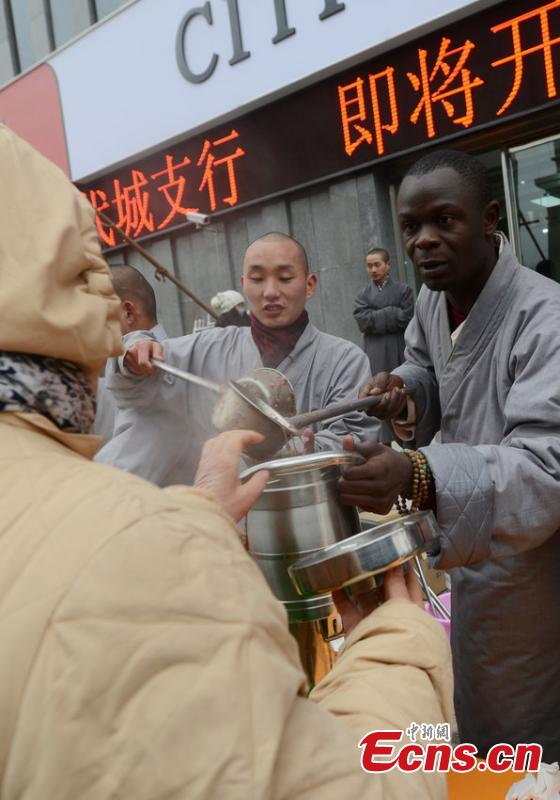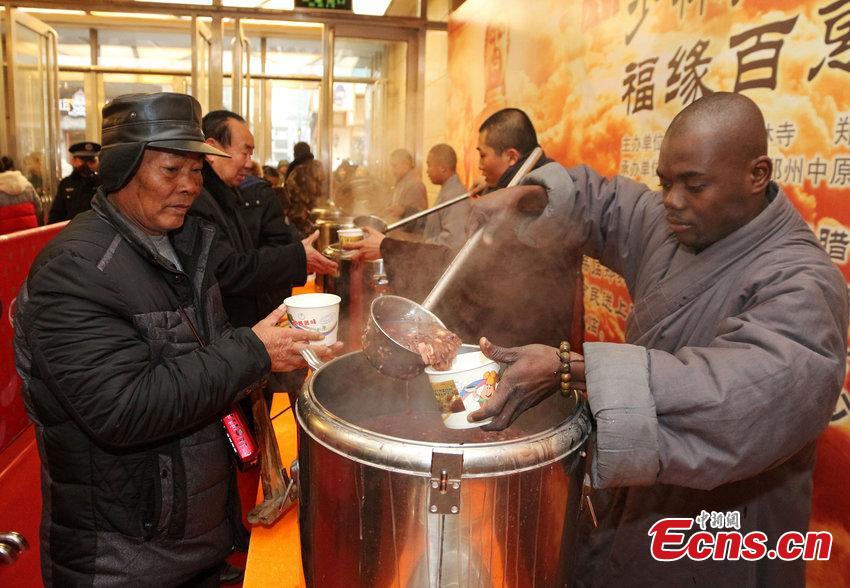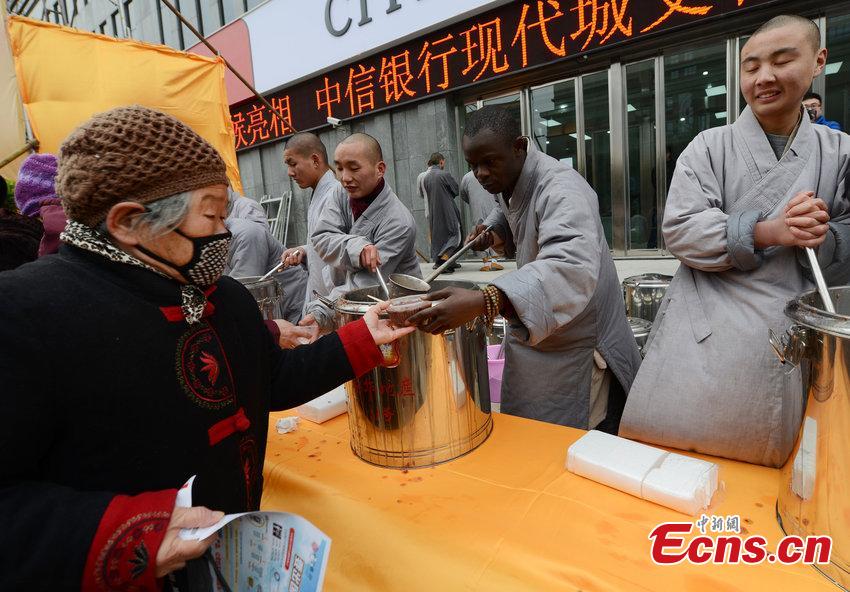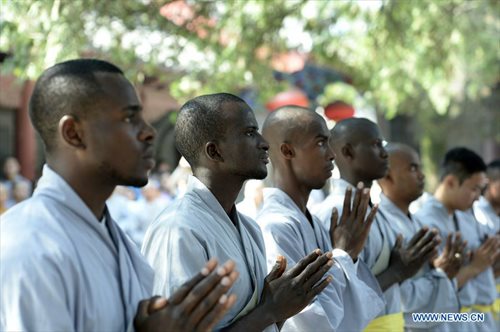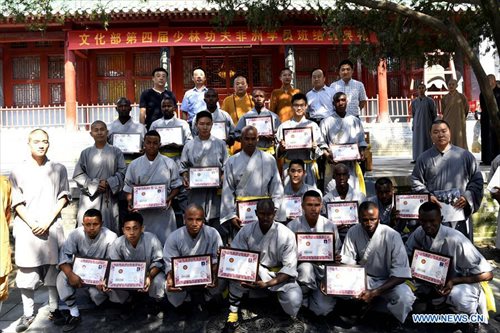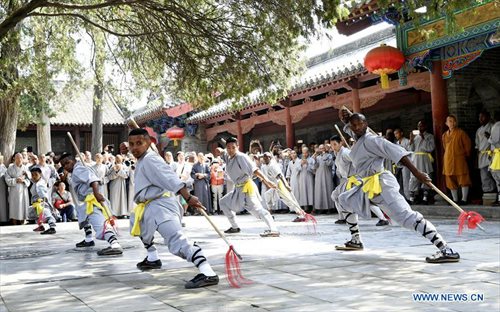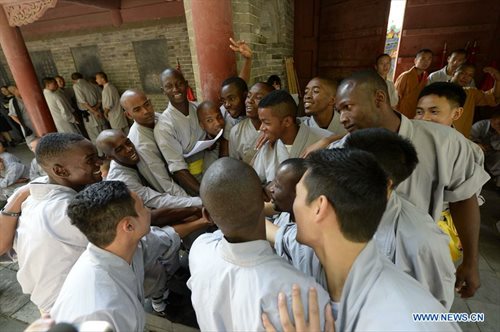A group of students look on as the shaven-headed monks demonstrate the basic stances of wushu, the backbone of Shaolin's fighting style, made famous worldwide by the moviemakers of Hong Kong and Hollywood.
These eager pupils are African, European and American. And while some made the pilgrimage to Shaolin seeking the fabled martial prowess that will stop an enemy's heart with a single blow, just as many say they came because they are looking for a professional edge.
As recently as a decade ago, foreign students were not common at Shaolin.
But as Valery Mabre knows first hand, things have changed.
The 23-year-old Ivorian, who came to Shaolin two years ago on a scholarship, spars with a group of shavenheaded Chinese monks.
The fluent Mandarin speaker and history graduate has set himself an ambitious goal.
"I want to be a kung fu master," he says. "If possible, I'd like to stay here and become a monk."
His fellow countryman Denis Banhoro, 55, wants something different out of his Shaolin experience.
The 55-year-old accountant, who is studying at the temple for a few months on a scholarship, is also the current national director of the Kung fu Federation of Cote d'Ivoire.
He believes the principles inherent in the kung fu he is learning can be applied to his professional life.
"I love Shaolin Kung fu, that is why I am here," he says. "I think Shaolin kung fu is good for your health, moreover, you need to use your head to think about it. It's not only an expression of the body. "
Demina Masoula, a 43-year-old business and marketing consultant who is part of a group from Greece that has come to study at Shaolin for about two weeks, agrees.
An executive for an insurance company and an engineer for a multinational corporation practice nearby while Masoula takes a breather from the demanding 4.30 am to 9 pm daily training regime.
"In business, you have to be flexible, you have to find new paths and change. You have to see a crisis and avoid it. Kung fu teaches you to be fluid, like water, because everything in kung fu flows and stagnation is bad."
Masoula thinks the temple has successfully struck the right balance commercially and culturally.
"They get people in to make money to maintain the culture and the history here, the martial arts itself."
Wang Yumin, dean of Shaolin's Foreign Affairs Office, says since January last year there have been about 800 foreigners who have come to live and train at the temple for periods ranging from a few days to more than 12 months.
He says the number of African students is on the rise.
"We are starting to see more African people here," Wang says. "We have some at the moment whose costs have been covered by the temple or the Chinese government's Ministry of Culture. A lot of Africans seem to love kung fu, so we are helping them come here. We want our way of life to help people spiritually and physically, and that includes Africans."
In the small city of Dengfeng at the base of Songshan mountain near Shaolin, more than 50,000 people train at 52 different kung fu schools annually.
Wang believes foreign students are specifically and increasingly seeking the "legitimacy" that he says Shaolin Temple offers.
But ideas about what constitutes authenticity in Chinese kung fu are contrary, and often subjective.
In an open-plan space on the fourth floor of a Beijing skyscraper, a mix of foreigners and locals throw kicks and punches at each other with a brutal efficiency that contrasts with the graceful flow of movement at Shaolin.
This is no accident, says Englishman-turned-Beijing-resident and professional martial artist Jai Harman.
The students are practicing ving tsun, a style renowned for its ruthless practicality. Many in the martial arts scene, such as Harman, believe it holds an authenticity Shaolin wushu is losing.
Harman, 30, who has lived in China for a decade, is a senior instructor at the Beijing Scientific Ving Tsun School. Ving tsun is an offshoot of Shaolin wu shu that is now ancient in its own right.
"Wu shu is a demonstrational form of kung fu," Harman says. "It has zero practicality for fighting. It's just good for building up the body. Ving tsun doesn't have any pretty poses; it's all about practicality."
Harman came to China on a kung fu pilgrimage to Shaolin, but what he found at the temple was not for him.
He sought out world-renowned ving tsun master Wang Zhi Peng, whose lineage boasts ties to marital artist and star of the silver screen Bruce Lee.
"Wang Zhi Peng's master's master was Yip Man, who also taught Bruce Lee," he says.
The Beijing Scientific Ving Tsun School has 400 regular students at several locations around the country, and a few thousand casual learners.
Many of them, like Lebanese business lawyer Rashad Tabet, 31, are for eigners living and working in China.
Harman says preserving, promoting and practicing ving tsun martial arts and culture is still at the heart of what the organization is all about. But he concedes the school is a business.
"We are very open about that," he says. "But making money is a sideline to what we do; it just lets us do what we do."
For all their differences, Harman concedes there is an undeniable common ground between ving tsun and wu shu. The basic skills and disciplines of both have practical applications for professionals.
Tabet the business lawyer agrees.
"You have to defend your centerline in business, just like you do in ving tsun. You don't know where the attacks will come from. You have to be on your guard 24/7 in the business world. Always be ready to defend. This is something I learned how to do from martial arts."
Shaolin Temple and Harman's school are not the only kung fu organizations experiencing a boom in business and popularity.
Sichuan-based Liu Suibin, the head of the Qingcheng faction of Daoism, has more than 468,000 followers on Chinese social media. His instructional tai chi video is available for download in the Apple app store, and is reportedly growing in popularity among office-bound executives and professionals looking for stress release and focus at work.
One of his books has also made China's bestseller list.
Abbot Shi generally shies away from talking about the commercial successes of Shaolin and why he's taken the order down a path that's led to financial sustainability.
But reading between the lines when he opens up about his own journey to enlightenment reveals much about the man and his mission.
Born in Anhui province, the son of a train driver, Shi arrived at Shaolin Temple in 1981 when he was 16-years-old. He found the place in disrepair. The monks, he says, "didn't have enough to eat."
"At that time, Shaolin didn't have so many visitors," Shi says. "The temple buildings were in poor condition, and more than 30 monks lived off 28 mu (less than one square kilometer) of farmland. The conditions were harsh and life was tough."
From 1987, Shi was able to help steer the future course of the order. In 1999, he became the abbot, and his reform agenda picked up pace.
"For 1,500 years, our belief, our way of practicing Buddhism has not changed," he says. "But our daily work has been changed. Historically, monks live off farming. Now they mainly work by serving tourists. We used to deal with farmlands, but now we deal with people, which is not as easy."
Shi Yanbo, 25, is part of the new generation of novice monks at Shaolin. He believes going back to the old ways doesn't make sense.
"Tourists are a test of our xiu xing (journey to enlightenment) because we have to make sure that our heart won't be affected by the noisy environment," he says.
"We have to accept it and remain calm and treat visitors with joyful hearts.
Shaolin belongs to the world now, and develops with the world. We cannot do farming otherwise people would not be able to visit us. All our traditional thoughts and beliefs have been maintained and carried on for generations. Our life maybe different, but what we practice is of the heart, and the heart remains unchanged."
As the sun disappears behind the forest clad Songshan mountain, the tourists empty out of Shaolin Temple. The monks sit quietly and chat beneath swooping squadrons of dragonflies in the gathering twilight, the scene a window into a simpler time before kung fu commercialized.
The Abbot says the temple's growing connectivity with the modern world is about survival, and about spreading the benefits of Shaolin wu shu to those who are seeking it, globally.
He hints that the kung fu wisdom he shares with executives is not just about people wanting to do better in business, but also about people who have done well in business, wanting something better.
"I tell business people how to behave in a good way, how to do things well," Shi says. "They need to be more confident, improve themselves, keep a normal heart toward things and believe that you reap what you sow."
In the ancient mountain fastness of Shaolin Temple, walking in the footsteps of generations of kung fu acolytes, Mabre says he has learned wu shu is about more than physical prowess. It's about mental discipline and the Buddhist drive for constant self-improvement, personal and professional.
"First you learn kung fu for your body," he says. 'Then you learn for the mind and the spirit."
Masoula says she believes the ancient soul of Shaolin hasn't been hijacked and turned into a business with a focus on profit. Maybe, she says, it's a case of kung fu in the 21st century giving business a new focus, and the wisdom to recognize that there is profit, in having a soul.





 Reply With Quote
Reply With Quote







